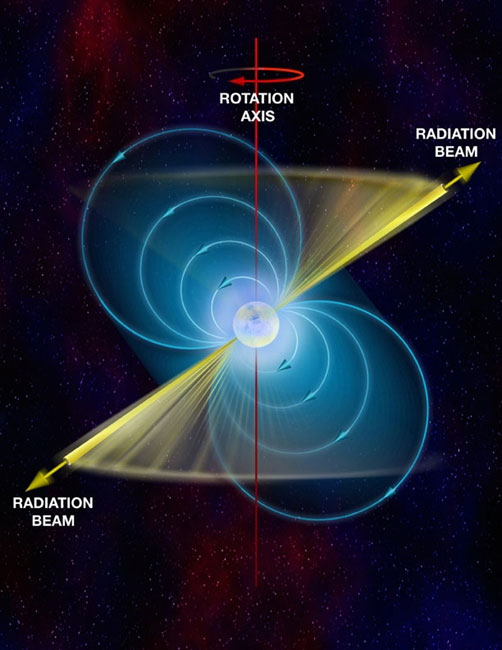Dark Star - Gift from the Universe
Dark stars - super-condensed neutron stars - also known as the most special Physics labs in the universe.These super-celestial studies have been awarded two Nobel prizes.
Researchers are now ready to learn about the unprecedented details of Atomic Physics, to verify general relativity in super-attractive conditions, and to directly detect gravitational waves with a large 'telescope' close to our own galaxy.
Neutron stars are remnants of giant stars that exploded in supernova explosions. They compress a volume of our Sun into a sphere smaller than a medium-sized city, creating the most condensed objects in the universe just after a black hole, which is about the theory of black hole condensation. is incomparable. Dark stars are neutron stars that emit radio waves from its magnetic poles. When spinning, they radiate this radio waves across the Earth, and radio telescopes will detect this radio wave 'pulse' .
By accurately measuring the time between these pulses, astronomers can use dark stars in unique experiments in the fields of modern physics.
Dark stars are in the early stages of studying gravity. Albert Einstein published General Relativity in 1916, his description of gravitational nature has so far stood before many verification experiments. However, there are many other opposition doctrines.

'Many alternative theories do well what general relativity has done to explain phenomena in the solar system. However, they differ in other areas; that makes the super-condensed environment of a neutron star . "said Ingrid Stairs from the University of British Columbia Canada.
According to some other theories, gravity will vary depending on the internal structure of the neutron star.
'By meticulously calculating the time of dark star pulses, we can accurately measure the properties of dark stars. Some observations show that dark stars move regardless of their structure, and so far Relativity is still safe, " Stairs said.
Recent research on dark stars and binary star systems with a dark star, and the case of two dark stars, provides the best experiments on general relativity in super-attractive environments. The accuracy of these calculations in the future is even more accurate, Stair adds.
Another prediction in general relativity says that the motion of metaphysics in the universe can cause space-time turbulence in gravitational waves. Although these waves have not been directly explored, studies of dark stars in binary star systems have proved its existence. This research was awarded the Nobel Prize in 1993.
Today astronomers are using dark stars in the Milky Way as a giant scientific tool to directly detect gravitational waves.
'Dark stars are so accurate clocks that we can use them to explore gravitational waves in the frequency range that other experiments cannot detect .' Benjamin Stappers confirmed from Manchester University. England.
With accurate measurements of pulses of dark stars scattered in the Milky Way series, astronomers hope to measure very small changes caused by moving gravitational waves. Scientists hope that pulses of dark stars can help discover gravitational waves produced by the movements of early cosmic supermassive black holes, in spaces, and also from strange events appear in the first few seconds after the Big Bang.
'Currently, we only set the limits of the existence of very low frequency waves that we are looking for, but the plan to expand and introduce new telescopes is expected to have direct detection results in one. the next decade " . Stappers said.
With a concentration of several times the concentration of atomic nuclei, dark stars are the unique labs of Atomic Physics. Information Physics about such condensed objects is still unknown.
'Measuring the masses of neutron stars helps us set physical constraints within them', says Scott Ransom, a National Radio Astronomical Observatory at Socorro State in New Mexico. For four years, we have discovered some giant neutron stars, and because their masses are so large, they collapse strange suggestions about what happens inside the neutron star's core. "
Research work is still ongoing, and more new measurements are needed.'The theorists are very intelligent, so when we provide them with new data, they refine their strange models in accordance with what we discover,' Ransom said.
Dark stars were discovered in 1967, and this discovery brought the Nobel Prize in 1974.
- 68% of dark energy in the universe may not exist
- NASA telescope set a new record
- The mystery of dark energy
- Detecting mysterious dark flows in the universe
- The truth about common reactions when giving gifts
- The formation of 'dark stars' in the universe
- Entering the universe 'dark'
- Determined the distribution of dark matter in the universe
- Evidence of life may exist in the parallel universe
- What is dark energy?
- Decipher the mystery of dark matter
- 10 mysteries in the universe
 Van Allen's belt and evidence that the Apollo 11 mission to the Moon was myth
Van Allen's belt and evidence that the Apollo 11 mission to the Moon was myth The levels of civilization in the universe (Kardashev scale)
The levels of civilization in the universe (Kardashev scale) Today Mars, the sun and the Earth are aligned
Today Mars, the sun and the Earth are aligned The Amazon owner announced a secret plan to build a space base for thousands of people
The Amazon owner announced a secret plan to build a space base for thousands of people